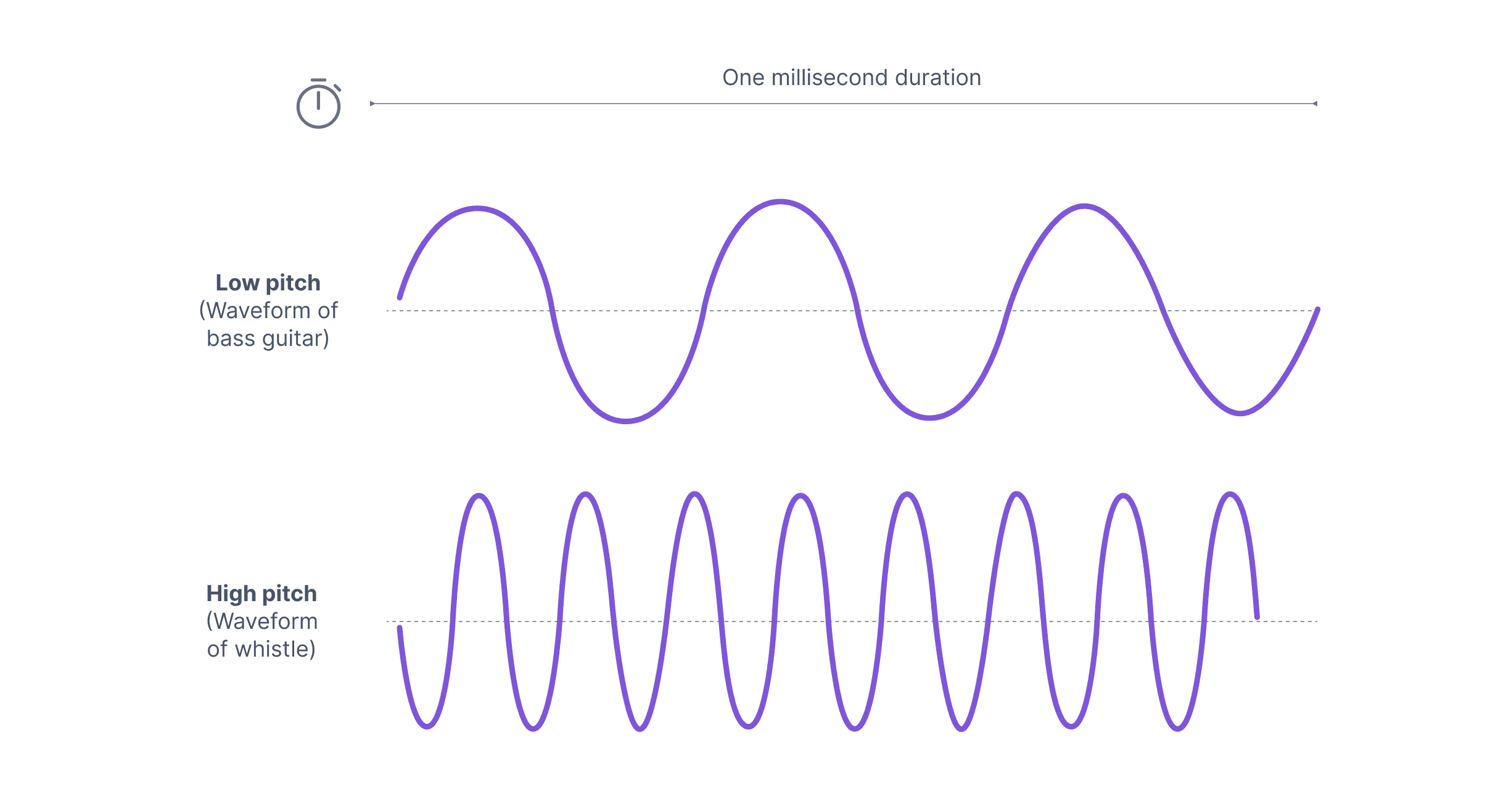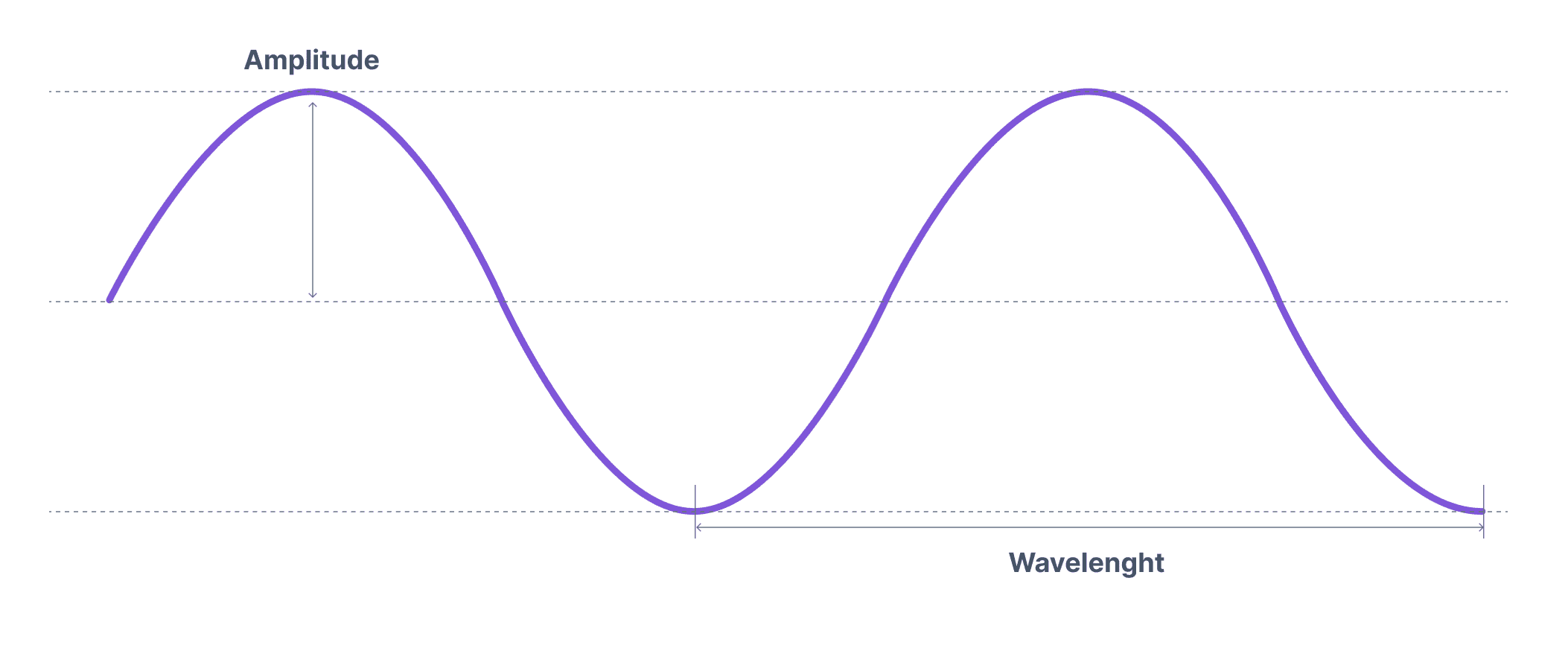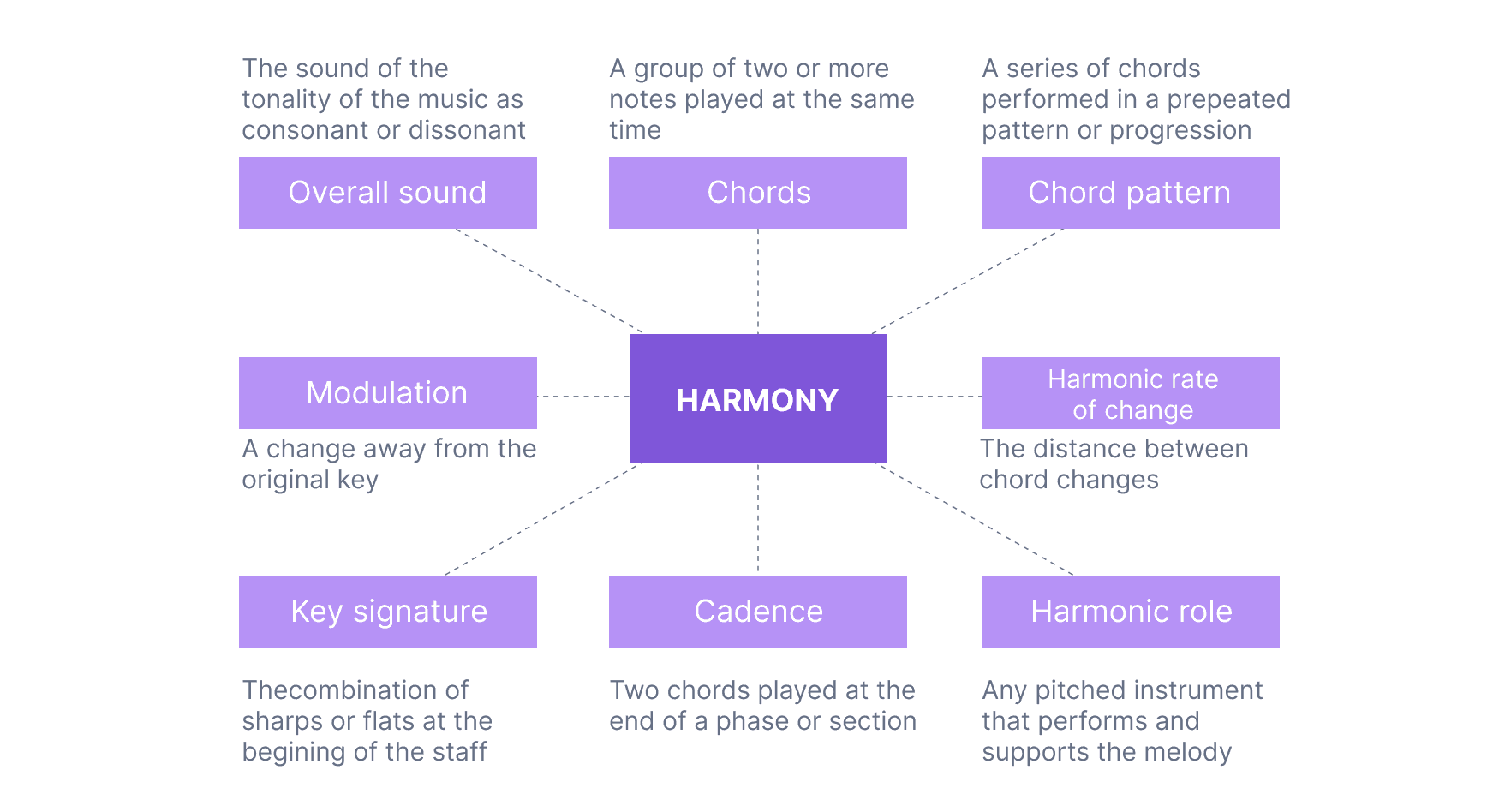
We are going to try to immerse ourselves fully into the sound and music terminology in order to be ready to read and listen to music branding conversation later on.
What is a soundwave?
Frequency or pitch
Frequency is the measurement of the number of times that a repeated event occurs per unit of time. The frequency of wave-like patterns including sound, electromagnetic waves (such as radio or light), electrical signals, or other waves, expresses the number of cycles of the repetitive waveform per second. In SI units, the result is measured in Hertz (Hz), 1 Hz means one cycle (or wave) per second. Frequency has an inverse relationship to the concept of wavelength (the distance between two peaks) such that the frequency is equal to the velocity divided by the wavelength. 1
When musicians talk about being "in tune" or "out of tune," they're referring to pitch, and more precisely, the relationship between two pitches. The more harmonious the mathematical connection between the two pitches is, the easier it is to hear if the notes are in tune.

Amplitude
Amplitude is the amount of energy contained in the sound wave and is perceived as being either loud or soft. Amplitude is measured in decibels (dB), but our perception of loud and soft changes depending on the sounds around us. Walking down a busy street at noon where the noise in the environment might average 50 decibels, we would find it difficult to hear the voice of a person next to us speaking at 40 decibels. On that same street at night that 40 decibel speaking voice will seem like a shout when the surrounding noise is only about 30 decibels. 2

Wave form
The waveform of a sound determines the tone color, or timbre that we hear and is how we can tell the difference between the sound produced by a voice, a guitar, and a saxophone even if they are playing the same frequency at the same amplitude. 3
The sine wave is the most basic waveform. Pure sine waves are uncommon in nature, but they are simple to produce using electrical methods. For example, the flute has a tone that is quite similar to that of a sine wave.
Duration
Every sound event has its unique duration, which we perceive as being either short or long, depending on the context. Several durations, one after another, create the rhythm of a piece.
Melody
A melody is a sequence of musical notes, a sequence of fundamental frequencies. To perform a melody, you'll need an instrument that can generate periodic sound waves over a wide range of fundamental frequencies, such as a guitar's strings. The relative fundamental frequencies of the notes, rather than their absolute frequencies, are more significant for the perception of melody and harmony.

Harmony
Harmony refers to the combination of notes to produce chords. A chord is a simultaneous combination of two or more notes. Chords with two notes are called dyads, chords with three notes are called triads, chords with four notes are called tetrads, and so on. The study of harmony is concerned with the principles underlying the perceptual effects of combining notes in chords. In a sense, melody and harmony represent two different directions in music, with reference to standard musical notation. Melody is concerned with the horizontal sequence of notes over time, whereas harmony is concerned with the vertical sequence of notes at a single time. 4

Tempo
A beat in music can be thought of as the tick of a clock (or metronome) in a musical piece, the basic unit of stress in time. It is not required to have a note or other musical event at each beat, and there may well be several events between two beats, but there is a sense that the time of each beat has a perceptual emphasis. The tempo of a musical piece is the rate at which beats occur and is usually measured in beats per minute (bpm). The tempo is also the rate at which we tend to tap our feet, or clap our hands, to the music. 5
Timbre | ˈtambər |
The Harvard Dictionary of Music describes timbre as “the character of a sound distinct from its pitch, length, or intensity; tone color.”
The word timbre, like pitch, refers to the subjective experience, not to the physical characteristics of the sound. The timbre of a complex tone depends in part on the relative magnitude of the various harmonics of which it is composed. It is this that distinguishes the ethereal purity of a flute, the sound of which is dominated by low harmonics, from the rich tone of a violin, which contains energy across a wide range of harmonics. Instruments that produce intense high-frequency harmonics (e.g., a trumpet) will tend to sound “bright.” Instruments that produce intense low-frequency harmonics (e.g., a French horn) will tend to sound “warm” or “dark.” These characteristics are evident even if the different instruments are playing the same note.
Texture
Texture in singing refers to the pattern of sound created by the interaction of musical voices. 6
There are different terminologies that indicate a variety of patterns identified as textures.
- Monophony is a single line of music occurring at a given time. This may be a solo (single performer) or performed in unison (multiple performers on the same line of music). Different instruments and voices can perform in monophony even if they are performing the lines in different octaves - think about a group all singing “Happy Birthday” together on the same note at the same time.
- Heterophony: almost like unison - except one voice will do a little more than the others - think of a solo gospel singer ornamenting/decorating the melody that the rest of the choir is singing. Homophony: two or more voices - one voice is the melody and the other voice(s) serve in support roles. This is the texture most Western Classical and popular music falls into - but many world music traditions do not adhere to this format.
- Polyphony: two or more voices moving independently from one another at the same time; also known as counterpoint. This can sound dissonant - with the two independent voices clashing - or it can sound consonant, with the musicians performing lines that interlock well with each other even though they’re very different from each other.

Conclusion
Although this is a brief and condensed summary of the principles and basics of sound and Psychoacoustics, the knowledge gained in this paragraph allows us to move forward in the journey of discovery of music branding, conscious that the basic principles will become useful when entering “vertical” conversations about music branding or sound in general.
-
1.
➚
Glossary: Frequency (in the context of sound). (n.d.). GreenFacts. Retrieved February 17, 2022, from GreenFacts
Cohen, D. (2020, May 29). 1.2: Elements of Sound. Link. Retrieved February 17, 2022.
Cohen, D. (2020, May 29). 1.2: Elements of Sound. Link. Retrieved February 17, 2022.
Plack, C. J. (2018). The Sense of Hearing. Routledge.
Plack, C. J. (2018). The Sense of Hearing. Routledge.
Apel, W. (1969). Harvard Dictionary of Music (W. Apel, Ed.). Belknap Press of Harvard University Press.